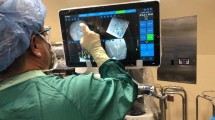Abstract
Pedicle screw fixation in pediatric spine surgery has become common practice given the fixation stability and improved curve correction. However, due to proximity to vital structures, accuracy is paramount. Literature has reported accuracy rates from 87.5 to 90% using traditional freehand techniques. This study presents our initial experience with pedicle screw placement using the newest generation of spinal robotics for treatment of pediatric spinal deformity. A cohort of patients, aged 8–21 years, undergoing spinal fusion surgery using robotic-assisted technology was reviewed. Diagnoses, Cobb angles, surgical time, robot time, number of screws placed, and complications were recorded. Accuracy of screw placement was assessed based on analysis of successful screw execution, evaluation screw position using intraoperative fluoroscopy and post-operative radiographs, and clinical evaluation. The average age was 14.5 years. Prevalent diagnoses included idiopathic (65%) and neuromuscular scoliosis (13%). Mean preoperative curve measured 66.8°. The median time for operation was 235 minutes with medians of 8 levels fused and 5 screws placed per patient. Of the 314 screws placed, we recorded a 98.7% accuracy rate. Lateral deviation was the most common cause of malpositioning. Post-operative plain films revealed no grossly misplaced screws. There were no perioperative neurologic deficits or malpositioned screws requiring reoperation. This is the first reported series of navigated spinal robotics used for pedicle screw placement in children. Our clinical success rate was 98.7% and there were no clinically relevant screw related complications. The study shows promising initial results of combined robotic-navigation techniques in pediatric patients.




Similar content being viewed by others
Data availability
Data and material is stored per IRB requirements at our institution.
Code availability
Not applicable.
References
D’Souza M, Gendreau J, Feng A, Kim LH, Ho AL, Veeravagu A (2019) Robotic-assisted spine surgery: history, efficacy, cost, and future trends. Robotic Surg 6:9–23
Benech CA, Perez R, Benech F, Greeley SL, Crawford N, Ledonio C (2019) Navigated robotic assistance results in improved screw accuracy and positive clinical outcomes: an evaluation of the first 54 cases. J Robotic Surg 14(3):431–437
Vardiman AB, Wallace DJ, Crawford NR, Riggleman JR, Ahrendtsen LA, Ledonio CG (2019) Pedicle screw accuracy in clinical utilization of minimally invasive navigated robot-assisted spine surgery. J Robotic Surg 14(3):409–413
Staub BN, Sadrameli SS (2019) The use of robotics in minimally invasive spine surgery. J Spine Surg 5(Suppl 1):S31–S40
Joseph JR, Smith BW, Liu X, Park P (2017) Current applications of robotics in spine surgery: a systematic review of the literature. Neurosurg Focus 42(5):E2
Weinstein SL, Dolan LA, Cheng JC, Danielsson A, Morcuende JA (2008) Adolescent idiopathic scoliosis. The Lancet 371(9623):1527–1537
Hicks JM, Singla A, Shen FH, Arlet V (2010) Complications of pedicle screw fixation in scoliosis surgery: a systematic review. Spine 35(11):E465–E470
Macke JJ, Woo R, Varich L (2016) Accuracy of robot-assisted pedicle screw placement for adolescent idiopathic scoliosis in the pediatric population. J Robotic Surg 10(2):145–150
Han X, Tian W, Liu Y, Liu B, He D, Sun Y, Zhang Q (2019) Safety and accuracy of robot-assisted versus fluoroscopy-assisted pedicle screw insertion in thoracolumbar spinal surgery: a prospective randomized controlled trial. J Neurosurg 30(5):615–622
Fan Y, Du JP, Liu JJ, Zhang JN, Qiao HH, Liu SC, Hao DJ (2018) Accuracy of pedicle screw placement comparing robot-assisted technology and the free-hand with fluoroscopy-guided method in spine surgery: an updated meta-analysis. Medicine 97(22):e10970
Karkenny AJ, Mendelis JR, Geller DS, Gomez JA (2019) The role of intraoperative navigation in orthopaedic surgery. JAAOS-J Am Acad Orthopaedic Surgeons 27(19):e849–e858
Meng XT, Guan XF, Zhang HL, He SS (2016) Computer navigation versus fluoroscopy-guided navigation for thoracic pedicle screw placement: a meta-analysis. Neurosurg Rev 39(3):385–391
Gunnarsson M, Kherad M, Ohlin A (2012) Optimization of radiation exposure and image quality of the cone-beam O-arm intraoperative imaging system in spinal surgery. J Spinal Disorders Tech 25(1):52–58
Hu X, Ohnmeiss DD, Lieberman IH (2013) Robotic-assisted pedicle screw placement: lessons learned from the first 102 patients. Eur Spine J 22(3):661–666
Huntsman KT, Riggleman JR, Ahrendtsen LA, Ledonio CG (2019) Navigated robot-guided pedicle screws placed successfully in single-position lateral lumbar interbody fusion. J Robotic Surg 14(4):643–647
Funding
None.
Author information
Authors and Affiliations
Contributions
All authors have participated in all aspects of this study and have met the requirements set forth by Boston Children's Hospital/Harvard Medical School.
Corresponding author
Ethics declarations
Conflicts of interest
Dr. Hedequist is a consultant for Medtronic. Dr. Gonzalez, Dr. Ghessese, and Danielle Cook do not have any disclosures or conflicts of interest.
Ethics approval
Not applicable.
Consent to participate
This is an IRB approved study. The consent requirements were waived.
Consent for publication
The authors consent for the presented material to be published. This work has not been published elsewhere.
Additional information
Publisher's Note
Springer Nature remains neutral with regard to jurisdictional claims in published maps and institutional affiliations.
Rights and permissions
About this article
Cite this article
Gonzalez, D., Ghessese, S., Cook, D. et al. Initial intraoperative experience with robotic-assisted pedicle screw placement with stealth navigation in pediatric spine deformity: an evaluation of the first 40 cases. J Robotic Surg 15, 687–693 (2021). https://doi.org/10.1007/s11701-020-01159-3
Received:
Accepted:
Published:
Issue Date:
DOI: https://doi.org/10.1007/s11701-020-01159-3




